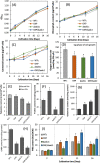The adc1 knockout with proC overexpression in Synechocystis sp. PCC 6803 induces a diversion of acetyl-CoA to produce more polyhydroxybutyrate
- PMID: 38218963
- PMCID: PMC10788017
- DOI: 10.1186/s13068-024-02458-9
The adc1 knockout with proC overexpression in Synechocystis sp. PCC 6803 induces a diversion of acetyl-CoA to produce more polyhydroxybutyrate
Abstract
Background: Lack of nutrients, in particular nitrogen and phosphorus, has been known in the field to sense glutamate production via 2-oxoglutarate and subsequently accelerate carbon storage, including glycogen and polyhydroxybutyrate (PHB), in cyanobacteria, but a few studies have focused on arginine catabolism. In this study, we first time demonstrated that gene manipulation on proC and adc1, related to proline and polyamine syntheses in arginine catabolism, had a significant impact on enhanced PHB production during late growth phase and nutrient-modified conditions. We constructed Synechocystis sp. PCC 6803 with an overexpressing proC gene, encoding Δ1pyrroline-5-carboxylate reductase in proline production, and adc1 disruption resulted in lower polyamine synthesis.
Results: Three engineered Synechocystis sp. PCC 6803 strains, including a ProC-overexpressing strain (OXP), adc1 mutant, and an OXP strain lacking the adc1 gene (OXP/Δadc1), certainly increased the PHB accumulation under nitrogen and phosphorus deficiency. The possible advantages of single proC overexpression include improved PHB and glycogen storage in late phase of growth and long-term stress situations. However, on day 7 of treatment, the synergistic impact created by OXP/Δadc1 increased PHB synthesis by approximately 48.9% of dry cell weight, resulting in a shorter response to nutrient stress than the OXP strain. Notably, changes in proline and glutamate contents in engineered strains, in particular OXP and OXP/Δadc1, not only partially balanced the intracellular C/N metabolism but also helped cells acclimate under nitrogen (N) and phosphorus (P) stress with higher chlorophyll a content in comparison with wild-type control.
Conclusions: In Synechocystis sp. PCC 6803, overexpression of proC resulted in a striking signal to PHB and glycogen accumulation after prolonged nutrient deprivation. When combined with the adc1 disruption, there was a notable increase in PHB production, particularly in situations where there was a strong C supply and a lack of N and P.
Keywords: Glutamate; Glycogen; PHB; Proline; Synechocystis sp. PCC 6803.
© 2024. The Author(s).
Conflict of interest statement
The authors declare that they have no competing interests.
Figures








Similar articles
-
Native putA Overexpression in Synechocystis sp. PCC 6803 Significantly Enhances Polyhydroxybutyrate Production, Further Augmented by the adc1 Knockout Under Prolonged Nitrogen Deprivation.Int J Mol Sci. 2025 Aug 13;26(16):7815. doi: 10.3390/ijms26167815. Int J Mol Sci. 2025. PMID: 40869139 Free PMC article.
-
Cyanobacterium Synechocystis sp. PCC 6803 lacking adc1 gene produces higher polyhydroxybutyrate accumulation under modified nutrients of acetate supplementation and nitrogen-phosphorus starvation.Biotechnol Rep (Amst). 2021 Jul 25;31:e00661. doi: 10.1016/j.btre.2021.e00661. eCollection 2021 Sep. Biotechnol Rep (Amst). 2021. PMID: 34386355 Free PMC article.
-
Requirement of the nitrogen starvation-induced protein Sll0783 for polyhydroxybutyrate accumulation in Synechocystis sp. strain PCC 6803.Appl Environ Microbiol. 2010 Sep;76(18):6101-7. doi: 10.1128/AEM.00484-10. Epub 2010 Jul 30. Appl Environ Microbiol. 2010. PMID: 20675451 Free PMC article.
-
Increased Biomass and Polyhydroxybutyrate Production by Synechocystis sp. PCC 6803 Overexpressing RuBisCO Genes.Int J Mol Sci. 2023 Mar 29;24(7):6415. doi: 10.3390/ijms24076415. Int J Mol Sci. 2023. PMID: 37047389 Free PMC article.
-
Polyhydroxybutyrate: A Useful Product of Chlorotic Cyanobacteria.Microb Physiol. 2021;31(2):67-77. doi: 10.1159/000515617. Epub 2021 May 12. Microb Physiol. 2021. PMID: 33979794 Review.
Cited by
-
Native putA Overexpression in Synechocystis sp. PCC 6803 Significantly Enhances Polyhydroxybutyrate Production, Further Augmented by the adc1 Knockout Under Prolonged Nitrogen Deprivation.Int J Mol Sci. 2025 Aug 13;26(16):7815. doi: 10.3390/ijms26167815. Int J Mol Sci. 2025. PMID: 40869139 Free PMC article.
References
-
- Sutherland DL, McCauley J, Labeeuw L, Ray P, Kuzhiumparambil U, Hall C, Doblin M, Nguyen LN, Ralph PJ. How microalgal biotechnology can assist with the UN Sustainable Development Goals for natural resource management. Curr Res Environ Sustain. 2021;3:100050. doi: 10.1016/j.crsust.2021.100050. - DOI
-
- Pathak J, Maurya PK, Singh SP, Häder D-P, Sinha RP. Cyanobacterial farming for environment friendly sustainable agriculture practices: innovations and perspectives. Front Environ Sci. 2018;6:7. doi: 10.3389/fenvs.2018.00007. - DOI
-
- Natesungnoen M, Pongrakhananon V, Lindblad P, Jantaro S. Overexpressing carotenoid biosynthetic genes in Synechocystis sp PCC 6803 improved intracellular pigments and antioxidant activity, which can decrease the viability and proliferation of lung cancer cells in vitro. Int J Mol Sci. 2023;24:9370. doi: 10.3390/ijms24119370. - DOI - PMC - PubMed
-
- Utharn S, Yodsang P, Incharoensakdi A, Jantaro S. Cyanobacterium Synechocystis sp. PCC 6803 lacking adc1 gene produces higher polyhydroxybutyrate accumulation under modified nutrients of acetate supplementation and nitrogen-phosphorus starvation. Biotechnol Rep. 2021;31:e00661. doi: 10.1016/j.btre.2021.e00661. - DOI - PMC - PubMed
Grants and funding
LinkOut - more resources
Full Text Sources
